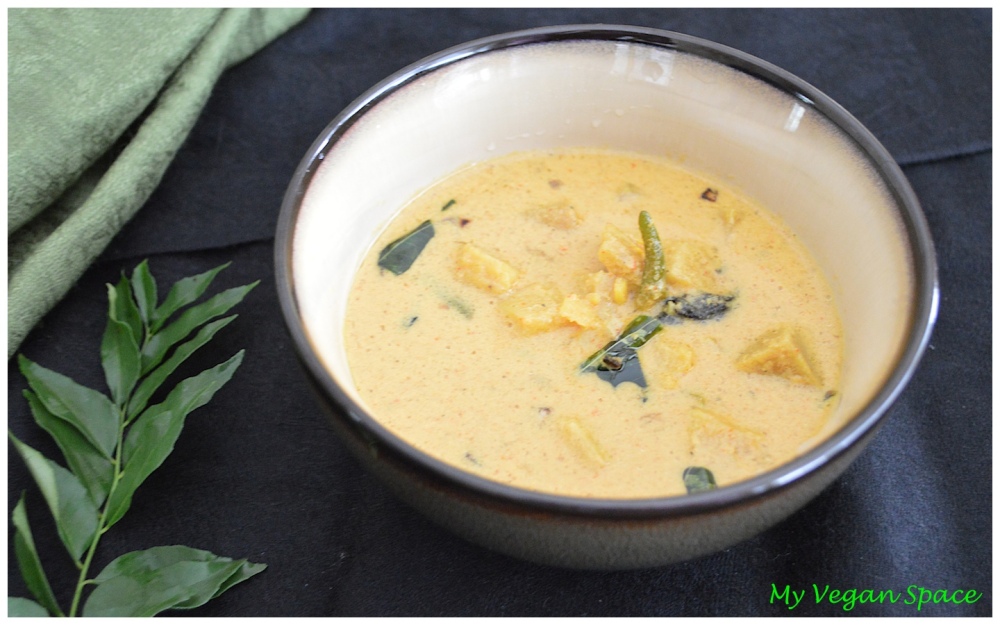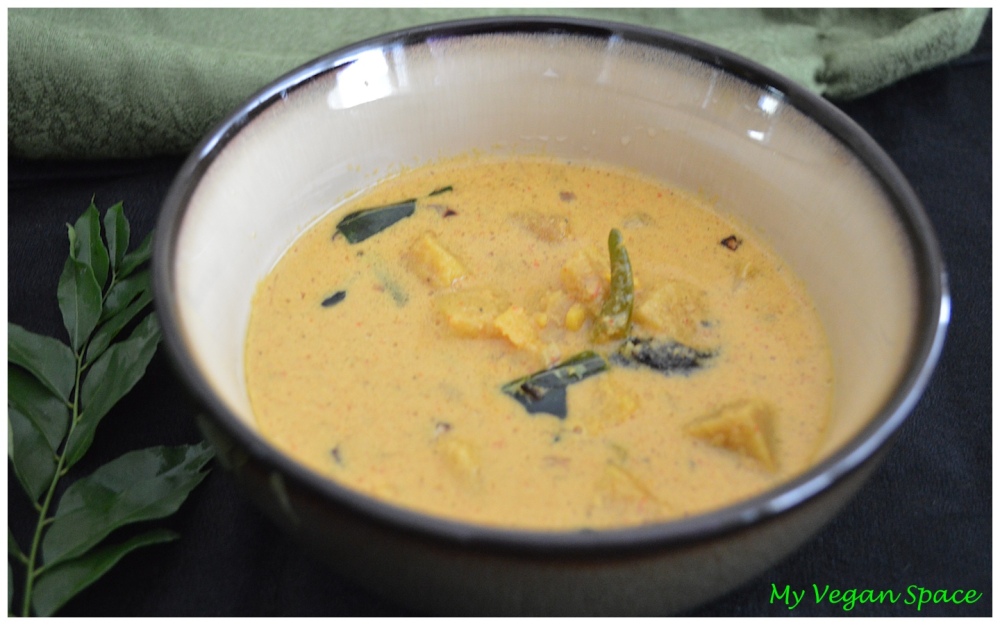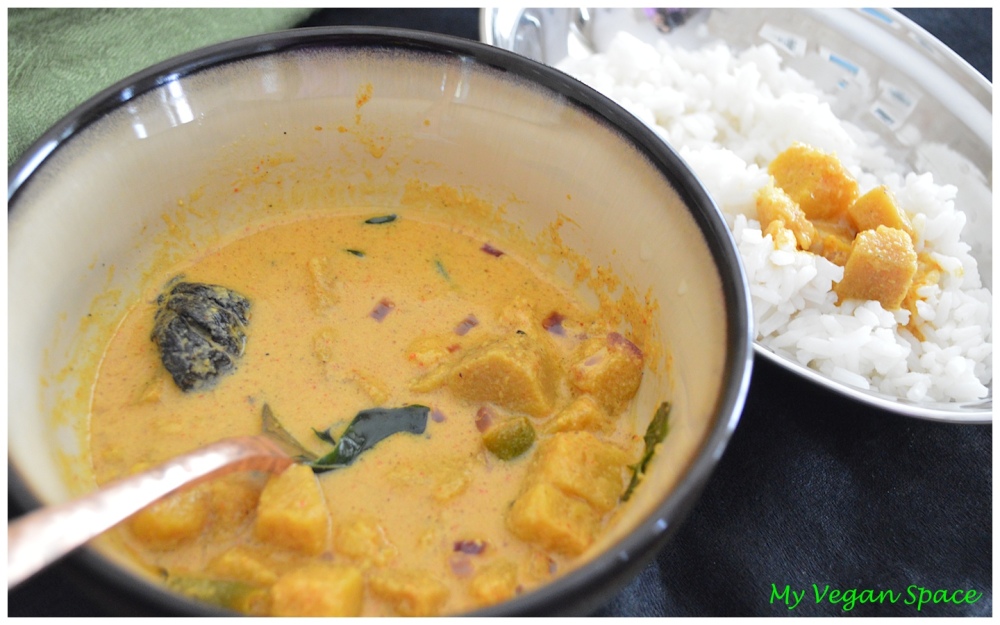 Elephant foot yam? Now what is that? My kids were stumped. What a weird name! But if you see this yam, which is like a super large yam or potato, it does indeed resemble an elephant’s foot! In Indian cuisine this yam is used in almost every region although it is called by different names – Oal in the East, Chena (Kerala), sennai kizhangu in Tamil, sudan in the west and jimmikhand in the North.
Elephant foot yam? Now what is that? My kids were stumped. What a weird name! But if you see this yam, which is like a super large yam or potato, it does indeed resemble an elephant’s foot! In Indian cuisine this yam is used in almost every region although it is called by different names – Oal in the East, Chena (Kerala), sennai kizhangu in Tamil, sudan in the west and jimmikhand in the North.
In Kerala cuisine this yam is used in Avial (the traditional mixed vegetable dish) and in other similar dishes. My mom used to also add it to her shrimp curry or fish curry at times. And that’s why last week when I was cooking fish curry for my family, I thought why not create a vegan version for myself! That way I can still taste the deliciousness of the curry with the kodampuli (black tamarind that is native to Kerala) which I love so much.! Hence this vegan version was born. Worked out quite efficiently for me actually since it took me the same amount of time -only 2 different pots to cook both versions of the curry.
Turns out that this yam has some medicinal benefits and is used in Ayurvedic system of medicine quite extensively.The curry turned out very tasty – how could it not? My fish curry is super famous after all with our family and friends! Of course, I don’t mean to brag 🙂
The unique flavor of this curry has a lot to do with using kodampuli(Garcinia cambogia). Kodampuli is a type of sour fruit that is indigenous to only kerala in india. It is available in Indian grocers that stock Kerala foods. If you are unable to get this item, you can substitute with tamarind or with green mangoes.
Linking to Throwback Thursdays. Also Linking to Fiesta Friday where 2 of my favorite co-bloggers – Jhuls @ The Not So Creative Cook and Apsara @ Eating Well Diary are co-hosting this week.

Ingredients: Method: Take a medium size cooking pot (I use earthen pot since that’s what’s used traditionally in Kerala and this imparts a nice smoky flavor to the curry). But you could use any stainless steel or non stick pot. Add the suran pieces into the pot. Next add the green chillies and the ginger. then add the turmeric powder, red chilli powder and salt. Next add the kodampuli that has been soaked in a tbsp of water for 5-10 mins(or you can use tamarind). Add the water. Place the pot on the stove on medium heat for about 2-3 minutes till you see the water boiling. Immediately put the burner on low simmer and cover the pot with a lid. Cook covered for about 10 minutes swirling the pot gently every 5 minutes or so in order to prevent the suran pieces from sticking to the pot. Next open the lid and add the coconut milk. Let simmer for about 3-4 minutes on low heat. Turn heat off. Heat the coconut oil in a tadka pan for about 30 seconds. Then add the chopped onions and saute till golden brown. Add the curry leaves with its stem. Pour all the coconut oil along with the onions and curry leaves into the pot. Serve with cooked parboiled rice. *For getting coconut milk: 1 1/4 cups of fresh grated coconut or (frozen grated coconut that has been thawed) 2 cups warm water (divided) Take the fresh grated coconut (or thawed frozen grated coconut) and add to a blender along with 1 cup of warm water. Blend for about 1-2 minutes. Then strain using a large strainer into a container. Next take the coconut from the strainer and again add to the blender with another 1 cup of warm water. Blend it again for about 1 minute and strain this milk into the pot so you will have approximately 2 cups of coconut milk.Yam coconut curry (Suran curry)

I had to Google that Elephant foot yam as this is my first time I heard the name. And I can say that I have seen some at the market if I can remember the look correctly. 😀 This curry sounds new to me, too, but I bet it tastes amazingly good. Thanks for sharing at this week’s FF party. x
LikeLike
I love senaikizhangu ad have missed it dearly, living outside India. If the frozen pices work well, I should also give this recipe a try!
LikeLiked by 1 person
yes Apsara the frozen ones worked well and it’s less work too since they are already cubed for you 🙂
LikeLike
Yum! I’ve never had elephant foot yam, but this looks delish! I know I’d use the tamarind = I love anything with tamarind in it! Thanks for sharing this with us on Throwback Thursday!
Mollie
LikeLiked by 1 person
thank you Mollie . And you can try this curry with any other yam or hard vegetable too. The curry is what is so tasty – tangy and spicy with the richness of coconut milk.
LikeLiked by 1 person
Reblogged this on Indu's International Kitchen and commented:
Vegan version of my fish curry. You can use any hard/root vegetable. I used suran or elephant foot yam.
LikeLike